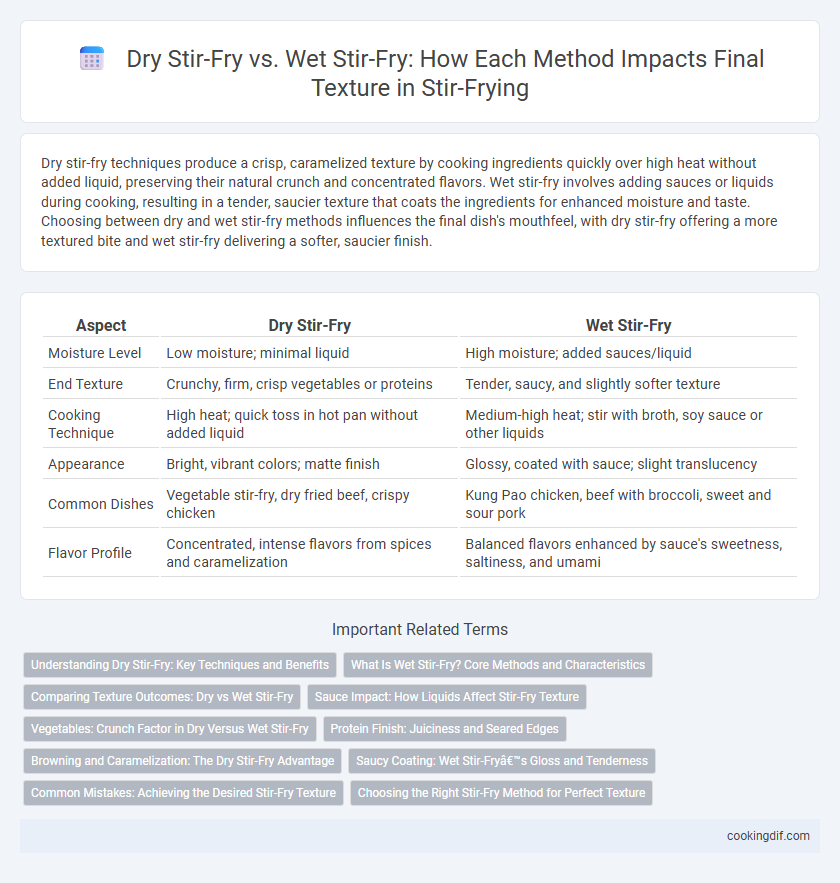Dry stir-fry techniques produce a crisp, caramelized texture by cooking ingredients quickly over high heat without added liquid, preserving their natural crunch and concentrated flavors. Wet stir-fry involves adding sauces or liquids during cooking, resulting in a tender, saucier texture that coats the ingredients for enhanced moisture and taste. Choosing between dry and wet stir-fry methods influences the final dish's mouthfeel, with dry stir-fry offering a more textured bite and wet stir-fry delivering a softer, saucier finish.
Table of Comparison
| Aspect | Dry Stir-Fry | Wet Stir-Fry |
|---|---|---|
| Moisture Level | Low moisture; minimal liquid | High moisture; added sauces/liquid |
| End Texture | Crunchy, firm, crisp vegetables or proteins | Tender, saucy, and slightly softer texture |
| Cooking Technique | High heat; quick toss in hot pan without added liquid | Medium-high heat; stir with broth, soy sauce or other liquids |
| Appearance | Bright, vibrant colors; matte finish | Glossy, coated with sauce; slight translucency |
| Common Dishes | Vegetable stir-fry, dry fried beef, crispy chicken | Kung Pao chicken, beef with broccoli, sweet and sour pork |
| Flavor Profile | Concentrated, intense flavors from spices and caramelization | Balanced flavors enhanced by sauce's sweetness, saltiness, and umami |
Understanding Dry Stir-Fry: Key Techniques and Benefits
Dry stir-fry involves cooking ingredients quickly over high heat with minimal oil, allowing vegetables and proteins to retain a crisp texture and vibrant color. Key techniques include maintaining a hot wok, constant stirring, and avoiding excess liquid to prevent steaming, resulting in a firmer, more textured dish. This method enhances the natural flavors and provides a satisfying bite compared to the softer, saucier texture of wet stir-fry.
What Is Wet Stir-Fry? Core Methods and Characteristics
Wet stir-fry involves cooking ingredients in a small amount of liquid, such as broth, water, or sauce, which creates a tender and juicy texture while preventing dryness. Core methods include quickly stir-frying aromatics and proteins first, then adding liquids to simmer briefly, allowing flavors to meld and the ingredients to retain slight crispness with a glossy finish. This technique contrasts with dry stir-fry, where minimal or no liquid is used, resulting in a chewier, more caramelized texture.
Comparing Texture Outcomes: Dry vs Wet Stir-Fry
Dry stir-fry produces a crisp, slightly caramelized texture by cooking ingredients quickly over high heat without added liquid, allowing moisture to evaporate rapidly. Wet stir-fry, in contrast, incorporates sauces or broths that create a tender, saucier finish while softening the food's surface. The choice between dry and wet stir-fry significantly influences the final mouthfeel and flavor concentration of the dish.
Sauce Impact: How Liquids Affect Stir-Fry Texture
Dry stir-fry techniques produce a crisp, caramelized texture by using minimal liquid, allowing ingredients to sear and retain firmness. Wet stir-fry incorporates sauces and liquids that create a glossy, tender finish, softening vegetables and meats while enhancing flavor absorption. Sauce viscosity and quantity directly influence the end texture, balancing between a dry, crunchy bite and a saucy, tender mouthfeel.
Vegetables: Crunch Factor in Dry Versus Wet Stir-Fry
Dry stir-fry cooking preserves the natural crunch of vegetables by using high heat and minimal liquid, allowing the fibers to remain firm and crisp. Wet stir-fry involves adding sauces or broths that steam the vegetables, resulting in a softer texture with less crunch. For maintaining optimal vegetable crispness, dry stir-fry techniques are preferred to achieve a desirable crunchy end texture.
Protein Finish: Juiciness and Seared Edges
Dry stir-fry techniques emphasize high heat and minimal moisture, producing proteins with a crisp, caramelized crust and pronounced seared edges that enhance texture and flavor. Wet stir-fry incorporates sauces or broths, resulting in a juicier protein finish but softer exterior without the distinctive sear. Selecting dry or wet stir-fry methods directly affects the balance between succulent juiciness and satisfying crispy edges in the final dish.
Browning and Caramelization: The Dry Stir-Fry Advantage
Dry stir-fry excels in browning and caramelization due to minimal moisture, allowing Maillard reactions that develop deeper flavors and a crispier texture. Wet stir-fry, with added liquids, inhibits browning by steaming ingredients, resulting in softer, less caramelized outcomes. The dry method enhances the end texture by promoting a rich, golden crust and intensified taste through concentrated sugars and proteins.
Saucy Coating: Wet Stir-Fry’s Gloss and Tenderness
Wet stir-fry techniques create a saucy coating that enhances the dish's gloss and tenderness by sealing in moisture and flavor. The liquid-based sauce clings to ingredients, producing a rich, glossy finish compared to the drier, crisper texture of dry stir-fry. This method optimizes moisture retention and integrates seasonings more thoroughly, resulting in a succulent and flavorful end texture.
Common Mistakes: Achieving the Desired Stir-Fry Texture
Dry stir-fry results in a crisp, caramelized texture by using high heat and minimal liquid, while wet stir-fry produces a tender, saucy finish with more moisture. Common mistakes include adding too much sauce too early, causing sogginess, or overcrowding the pan, which lowers the temperature and prevents proper searing. Maintaining intense heat and controlling liquid quantity are essential for achieving the perfect stir-fry texture.
Choosing the Right Stir-Fry Method for Perfect Texture
Dry stir-fry involves cooking ingredients quickly over high heat with minimal oil, resulting in a crisp, lightly browned exterior and retaining the natural crunch of vegetables. Wet stir-fry incorporates a flavorful sauce or broth, creating a tender, saucier texture that enhances moisture and blends flavors. Selecting dry or wet stir-fry depends on the desired end texture--crisp and distinct for dry, or soft and saucy for wet--ensuring the perfect balance in every bite.
Dry stir-fry vs wet stir-fry for end texture Infographic

 cookingdif.com
cookingdif.com